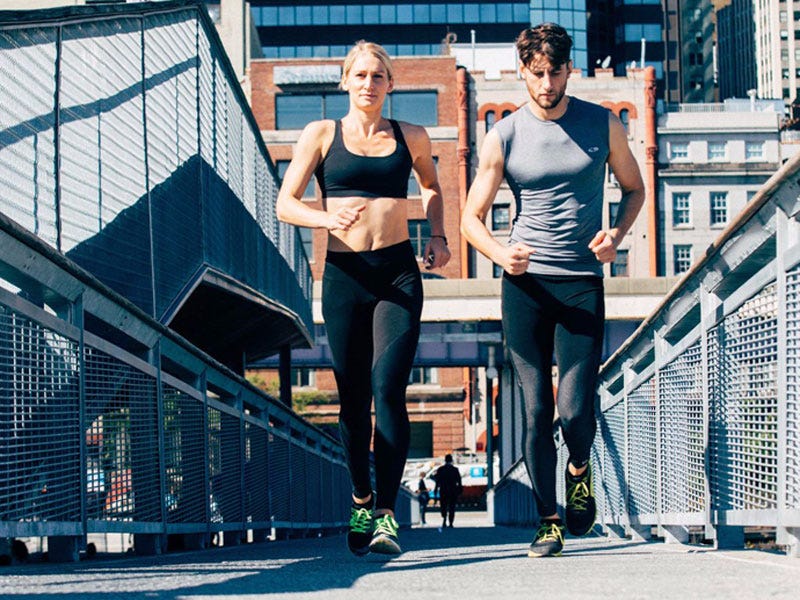Whether you’ve hit the gym for the first time in months, or just recently amped up your workout intensity, you’re probably experiencing delayed onset muscle soreness -otherwise known as DOMS. Even the fittest athletes experience muscle soreness -it’s the unfortunate part about growth.
DOMS can last for days after a tough workout, making it agonizing to complete simple tasks like standing up or climbing stairs, and if you’re not doing everything you can to help your muscles recover, you might just give up on your fitness goals altogether.
To make sure that doesn’t happen, try these seven tools to improve muscle recovery, so you can bounce back and hit the gym sooner, and stronger than ever!
- More exercise
Physical activity is probably the last thing you want to do when it hurts to move, but believe it or not, it should be the first thing on your mind. We’re not saying you need to go out and do the same workout that made you sore in the first place, but getting glued to the couch certainly won’t help you recover.
You’ll run the risk of injuring yourself if you push too hard, so you need to define the line between active recovery and an actual workout. If you’re working an entirely different muscle group, you’ll be safe from injury or overuse.
However, working a different muscle group won’t really help those sore muscles much, so you need to do active recovery. Whether you get out and take a walk, a light jog, a bike ride, or a swim, simply getting your heart rate up will help to flush lactic acid from your sore muscles, and get you on the way toward recovery.
In fact, you might notice a big difference in muscle soreness immediately following an active recovery session, so get off the couch and get moving!
- Take an ice bath
Ice baths aren’t just for professional athletes! It’s not as extreme as you might think, and the benefits of taking ice baths extend well beyond aiding muscle recovery.
It’s understandable to be a little hesitant to jump into a tub full of ice water -seems pretty uncomfortable, we agree. However, getting past that mental obstacle will only help to train your mind to deal with everyday stressors, more effectively regulate the production of cortisol, as well as improve muscle recovery.
Taking an ice bath will reduce the amount of inflammation caused by intense exercise. When you submerge yourself in ice water, your blood vessels constrict, reducing the blood flow through the affected areas. When you get out of the ice water, your blood vessels dilate, essentially opening the floodgates and allowing your body to naturally flush toxins and metabolic waste from worn muscles.
If you don’t have access to a bathtub, you can always stop by a home improvement store near you and pick up a new trash can! If that’s not an option either, simply apply an ice pack to your sore muscles. Just make sure you don’t leave the ice pack on for more than 20 minutes!
- Apply heat
Applying a heating improves muscle recovery in a similar way to that of an ice bath. Get a heating pad and place it on the sore muscles for 10-20 minutes. This will soothe the soreness and help to open up your blood vessels, simultaneously flushing out toxins and lactic acid buildup.
Anytime you give your muscles a flush, you’re getting rid of the old junk and allowing fresh oxygen and nutrients to speed up the process of muscle repair -helping you feel less sore!
- Massage your muscles
There are countless gadgets you can buy on the internet to help you massage your sore muscles, and they’re popular for a reason. Whether it’s a simple foam roller or a Theragun, getting deep into the tissues of your muscles promotes healthy blood flow into the region, bringing in fresh oxygen and nutrients.
If you’re able to do so, spending time with a massage therapist can help not only muscle recovery, but with your posture and overall flexibility as well!
- Use cannabis
Whether you’re working out to help treat and recover from existing health conditions, or simply want to shed a few pounds, using cannabis can help you recover more quickly! When thinking about using cannabis, you might picture a giggling hippie snacking on a bag of cheetos, but it’s medicinal properties are undeniable, so much so that it’s been legalized in 36 states!
When it comes to recovery, cannabis doesn’t help directly, but it does set your muscles up for success. One of the naturally occurring chemical compounds in cannabis are known to have anti-inflammatory effects, while also working as mild muscle relaxers.
Reducing inflammation improves blood flow and the delivery of nutrients, while relaxation allows needed rest to occur.
Using cannabis in various forms comes with a wide range of health benefits, and can be used to treat a vast number of both physical and mental health conditions. To learn more about how cannabis can be used to treat a variety of symptoms, check out this article on Veriheal.
- Drink more water
Water is essential for humans to survive. Whether you’re working out on a regular basis or not, you should be drinking enough water everyday. Your body is composed of somewhere around 60% water, so not getting enough is literally killing you!
Water flushes out toxins from the body and helps deliver nutrients to cells, so getting enough is crucial if you want to optimize your recovery time. To get the most out of the water you drink, make sure you drink it consistently throughout the day, rather than in short bursts of forced hydration.
- Sleep
Lastly, but certainly not least -sleep. Your body makes the most repairs to worn and damaged muscle fibers during sleep, so make sure you’re getting enough. Make sure you’re getting between 7-9 hours of sleep each night, and if you want to reduce your recovery time even more -take a nap during the day!
Conclusion
Sore muscles don’t have to hold you back for long. Use these seven tools to improve muscle recovery so you can get right back in the action tomorrow!







